Edinburgh Napier University: Individual Differences Essay
VerifiedAdded on 2022/08/24
|8
|2230
|30
Essay
AI Summary
This essay delves into the realm of individual differences within psychology, focusing on two key areas: intelligence and creativity. The first section critically evaluates Howard Gardner's Theory of Multiple Intelligences, exploring its comprehensive view and implications. The essay examines different types of learners, and the concept of intelligence. The second section shifts the focus to creativity, defining it as the generation of novel and valuable products. It explores the psychological constructs associated with creativity, including the four Ps (process, product, person, and place). The essay also examines four different methods for assessing creativity. It discusses the Guilford Model, the Taxonomy of Creative Design, the Requirements Model, and the Csikszentmihalyi’s Systems Model, providing a detailed overview of each assessment approach and its application in evaluating creative work. The essay concludes by emphasizing the importance of early experiences in fostering learning abilities and creativity.
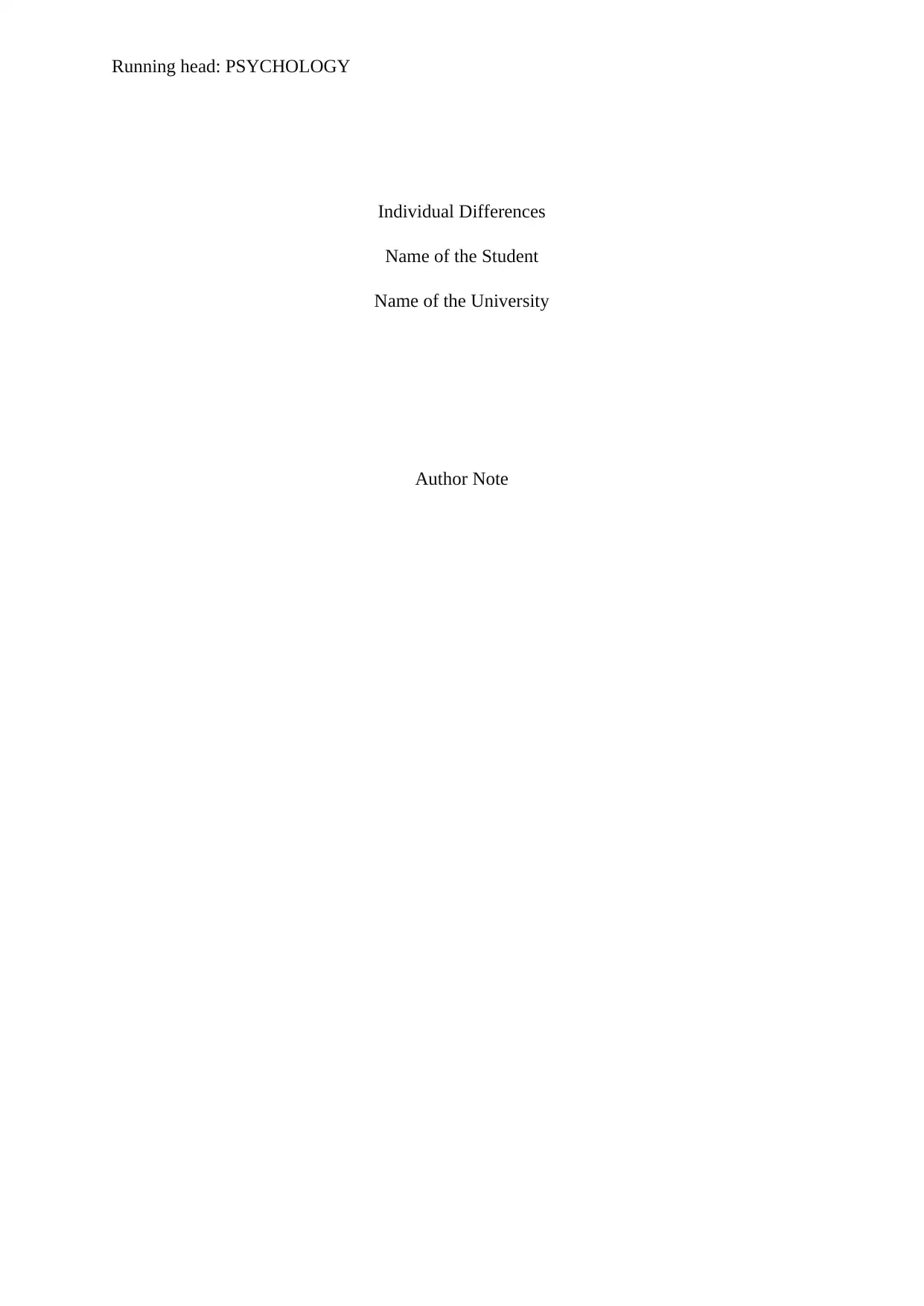
Running head: PSYCHOLOGY
Individual Differences
Name of the Student
Name of the University
Author Note
Individual Differences
Name of the Student
Name of the University
Author Note
Paraphrase This Document
Need a fresh take? Get an instant paraphrase of this document with our AI Paraphraser
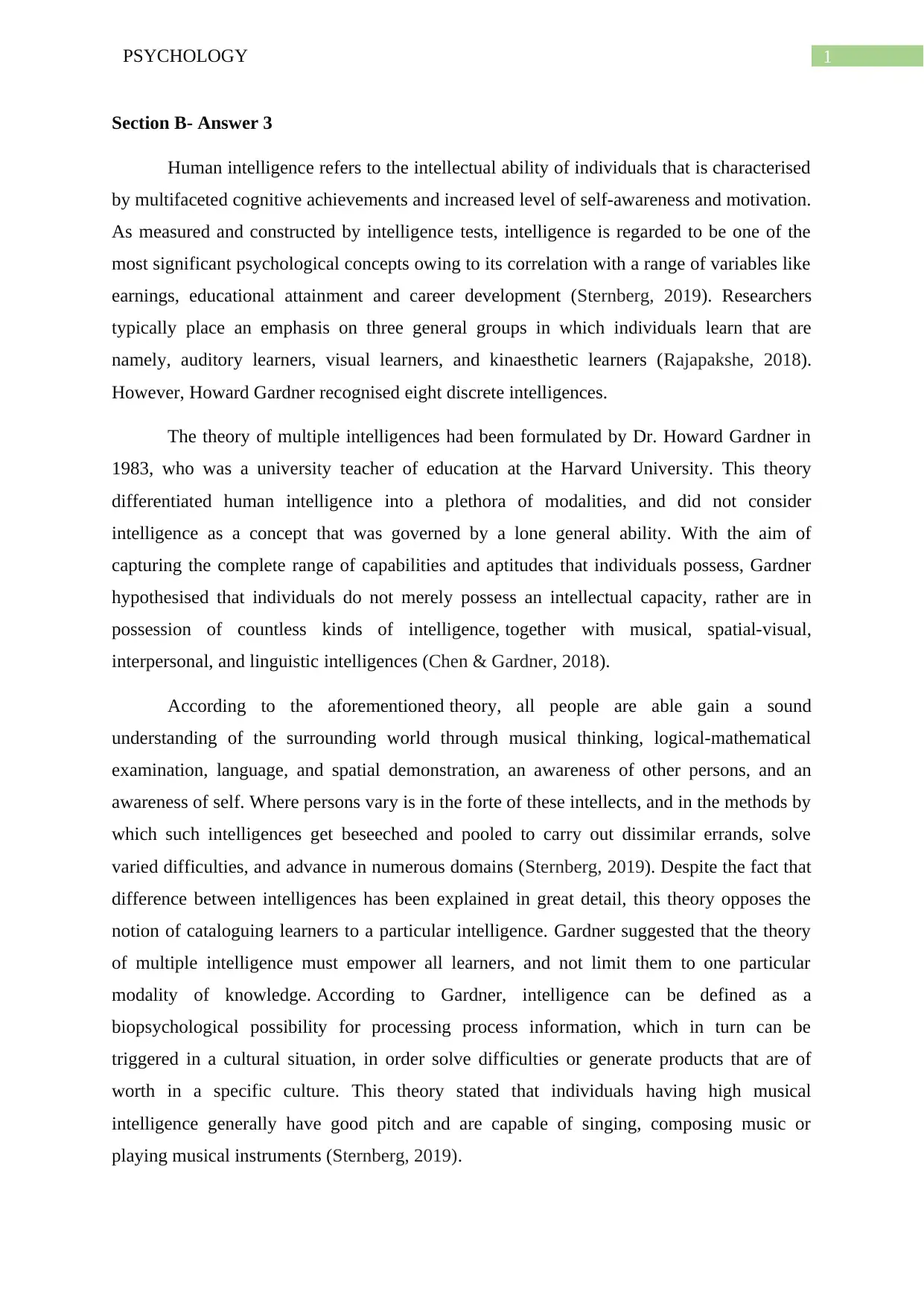
1PSYCHOLOGY
Section B- Answer 3
Human intelligence refers to the intellectual ability of individuals that is characterised
by multifaceted cognitive achievements and increased level of self-awareness and motivation.
As measured and constructed by intelligence tests, intelligence is regarded to be one of the
most significant psychological concepts owing to its correlation with a range of variables like
earnings, educational attainment and career development (Sternberg, 2019). Researchers
typically place an emphasis on three general groups in which individuals learn that are
namely, auditory learners, visual learners, and kinaesthetic learners (Rajapakshe, 2018).
However, Howard Gardner recognised eight discrete intelligences.
The theory of multiple intelligences had been formulated by Dr. Howard Gardner in
1983, who was a university teacher of education at the Harvard University. This theory
differentiated human intelligence into a plethora of modalities, and did not consider
intelligence as a concept that was governed by a lone general ability. With the aim of
capturing the complete range of capabilities and aptitudes that individuals possess, Gardner
hypothesised that individuals do not merely possess an intellectual capacity, rather are in
possession of countless kinds of intelligence, together with musical, spatial-visual,
interpersonal, and linguistic intelligences (Chen & Gardner, 2018).
According to the aforementioned theory, all people are able gain a sound
understanding of the surrounding world through musical thinking, logical-mathematical
examination, language, and spatial demonstration, an awareness of other persons, and an
awareness of self. Where persons vary is in the forte of these intellects, and in the methods by
which such intelligences get beseeched and pooled to carry out dissimilar errands, solve
varied difficulties, and advance in numerous domains (Sternberg, 2019). Despite the fact that
difference between intelligences has been explained in great detail, this theory opposes the
notion of cataloguing learners to a particular intelligence. Gardner suggested that the theory
of multiple intelligence must empower all learners, and not limit them to one particular
modality of knowledge. According to Gardner, intelligence can be defined as a
biopsychological possibility for processing process information, which in turn can be
triggered in a cultural situation, in order solve difficulties or generate products that are of
worth in a specific culture. This theory stated that individuals having high musical
intelligence generally have good pitch and are capable of singing, composing music or
playing musical instruments (Sternberg, 2019).
Section B- Answer 3
Human intelligence refers to the intellectual ability of individuals that is characterised
by multifaceted cognitive achievements and increased level of self-awareness and motivation.
As measured and constructed by intelligence tests, intelligence is regarded to be one of the
most significant psychological concepts owing to its correlation with a range of variables like
earnings, educational attainment and career development (Sternberg, 2019). Researchers
typically place an emphasis on three general groups in which individuals learn that are
namely, auditory learners, visual learners, and kinaesthetic learners (Rajapakshe, 2018).
However, Howard Gardner recognised eight discrete intelligences.
The theory of multiple intelligences had been formulated by Dr. Howard Gardner in
1983, who was a university teacher of education at the Harvard University. This theory
differentiated human intelligence into a plethora of modalities, and did not consider
intelligence as a concept that was governed by a lone general ability. With the aim of
capturing the complete range of capabilities and aptitudes that individuals possess, Gardner
hypothesised that individuals do not merely possess an intellectual capacity, rather are in
possession of countless kinds of intelligence, together with musical, spatial-visual,
interpersonal, and linguistic intelligences (Chen & Gardner, 2018).
According to the aforementioned theory, all people are able gain a sound
understanding of the surrounding world through musical thinking, logical-mathematical
examination, language, and spatial demonstration, an awareness of other persons, and an
awareness of self. Where persons vary is in the forte of these intellects, and in the methods by
which such intelligences get beseeched and pooled to carry out dissimilar errands, solve
varied difficulties, and advance in numerous domains (Sternberg, 2019). Despite the fact that
difference between intelligences has been explained in great detail, this theory opposes the
notion of cataloguing learners to a particular intelligence. Gardner suggested that the theory
of multiple intelligence must empower all learners, and not limit them to one particular
modality of knowledge. According to Gardner, intelligence can be defined as a
biopsychological possibility for processing process information, which in turn can be
triggered in a cultural situation, in order solve difficulties or generate products that are of
worth in a specific culture. This theory stated that individuals having high musical
intelligence generally have good pitch and are capable of singing, composing music or
playing musical instruments (Sternberg, 2019).
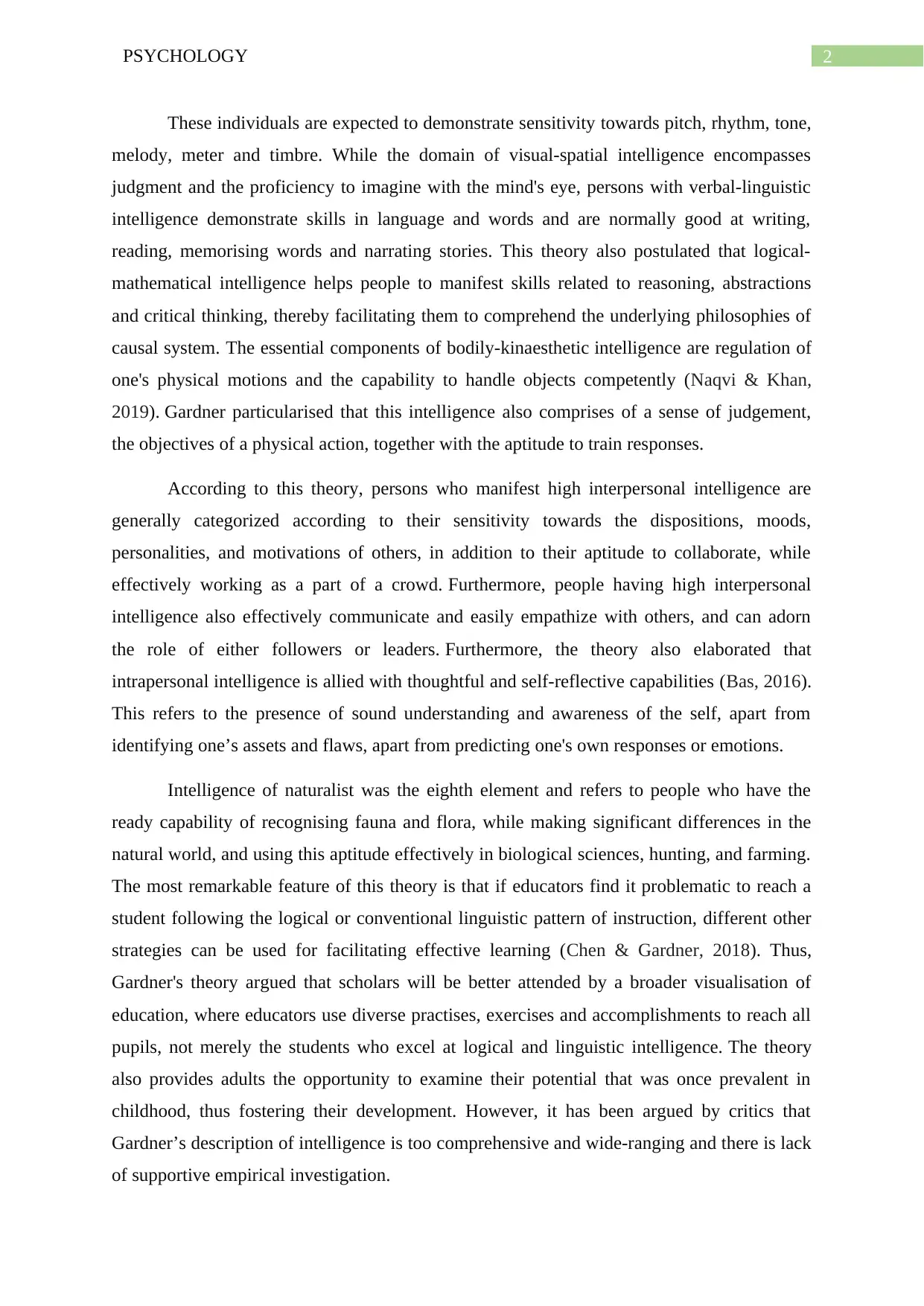
2PSYCHOLOGY
These individuals are expected to demonstrate sensitivity towards pitch, rhythm, tone,
melody, meter and timbre. While the domain of visual-spatial intelligence encompasses
judgment and the proficiency to imagine with the mind's eye, persons with verbal-linguistic
intelligence demonstrate skills in language and words and are normally good at writing,
reading, memorising words and narrating stories. This theory also postulated that logical-
mathematical intelligence helps people to manifest skills related to reasoning, abstractions
and critical thinking, thereby facilitating them to comprehend the underlying philosophies of
causal system. The essential components of bodily-kinaesthetic intelligence are regulation of
one's physical motions and the capability to handle objects competently (Naqvi & Khan,
2019). Gardner particularised that this intelligence also comprises of a sense of judgement,
the objectives of a physical action, together with the aptitude to train responses.
According to this theory, persons who manifest high interpersonal intelligence are
generally categorized according to their sensitivity towards the dispositions, moods,
personalities, and motivations of others, in addition to their aptitude to collaborate, while
effectively working as a part of a crowd. Furthermore, people having high interpersonal
intelligence also effectively communicate and easily empathize with others, and can adorn
the role of either followers or leaders. Furthermore, the theory also elaborated that
intrapersonal intelligence is allied with thoughtful and self-reflective capabilities (Bas, 2016).
This refers to the presence of sound understanding and awareness of the self, apart from
identifying one’s assets and flaws, apart from predicting one's own responses or emotions.
Intelligence of naturalist was the eighth element and refers to people who have the
ready capability of recognising fauna and flora, while making significant differences in the
natural world, and using this aptitude effectively in biological sciences, hunting, and farming.
The most remarkable feature of this theory is that if educators find it problematic to reach a
student following the logical or conventional linguistic pattern of instruction, different other
strategies can be used for facilitating effective learning (Chen & Gardner, 2018). Thus,
Gardner's theory argued that scholars will be better attended by a broader visualisation of
education, where educators use diverse practises, exercises and accomplishments to reach all
pupils, not merely the students who excel at logical and linguistic intelligence. The theory
also provides adults the opportunity to examine their potential that was once prevalent in
childhood, thus fostering their development. However, it has been argued by critics that
Gardner’s description of intelligence is too comprehensive and wide-ranging and there is lack
of supportive empirical investigation.
These individuals are expected to demonstrate sensitivity towards pitch, rhythm, tone,
melody, meter and timbre. While the domain of visual-spatial intelligence encompasses
judgment and the proficiency to imagine with the mind's eye, persons with verbal-linguistic
intelligence demonstrate skills in language and words and are normally good at writing,
reading, memorising words and narrating stories. This theory also postulated that logical-
mathematical intelligence helps people to manifest skills related to reasoning, abstractions
and critical thinking, thereby facilitating them to comprehend the underlying philosophies of
causal system. The essential components of bodily-kinaesthetic intelligence are regulation of
one's physical motions and the capability to handle objects competently (Naqvi & Khan,
2019). Gardner particularised that this intelligence also comprises of a sense of judgement,
the objectives of a physical action, together with the aptitude to train responses.
According to this theory, persons who manifest high interpersonal intelligence are
generally categorized according to their sensitivity towards the dispositions, moods,
personalities, and motivations of others, in addition to their aptitude to collaborate, while
effectively working as a part of a crowd. Furthermore, people having high interpersonal
intelligence also effectively communicate and easily empathize with others, and can adorn
the role of either followers or leaders. Furthermore, the theory also elaborated that
intrapersonal intelligence is allied with thoughtful and self-reflective capabilities (Bas, 2016).
This refers to the presence of sound understanding and awareness of the self, apart from
identifying one’s assets and flaws, apart from predicting one's own responses or emotions.
Intelligence of naturalist was the eighth element and refers to people who have the
ready capability of recognising fauna and flora, while making significant differences in the
natural world, and using this aptitude effectively in biological sciences, hunting, and farming.
The most remarkable feature of this theory is that if educators find it problematic to reach a
student following the logical or conventional linguistic pattern of instruction, different other
strategies can be used for facilitating effective learning (Chen & Gardner, 2018). Thus,
Gardner's theory argued that scholars will be better attended by a broader visualisation of
education, where educators use diverse practises, exercises and accomplishments to reach all
pupils, not merely the students who excel at logical and linguistic intelligence. The theory
also provides adults the opportunity to examine their potential that was once prevalent in
childhood, thus fostering their development. However, it has been argued by critics that
Gardner’s description of intelligence is too comprehensive and wide-ranging and there is lack
of supportive empirical investigation.
⊘ This is a preview!⊘
Do you want full access?
Subscribe today to unlock all pages.

Trusted by 1+ million students worldwide
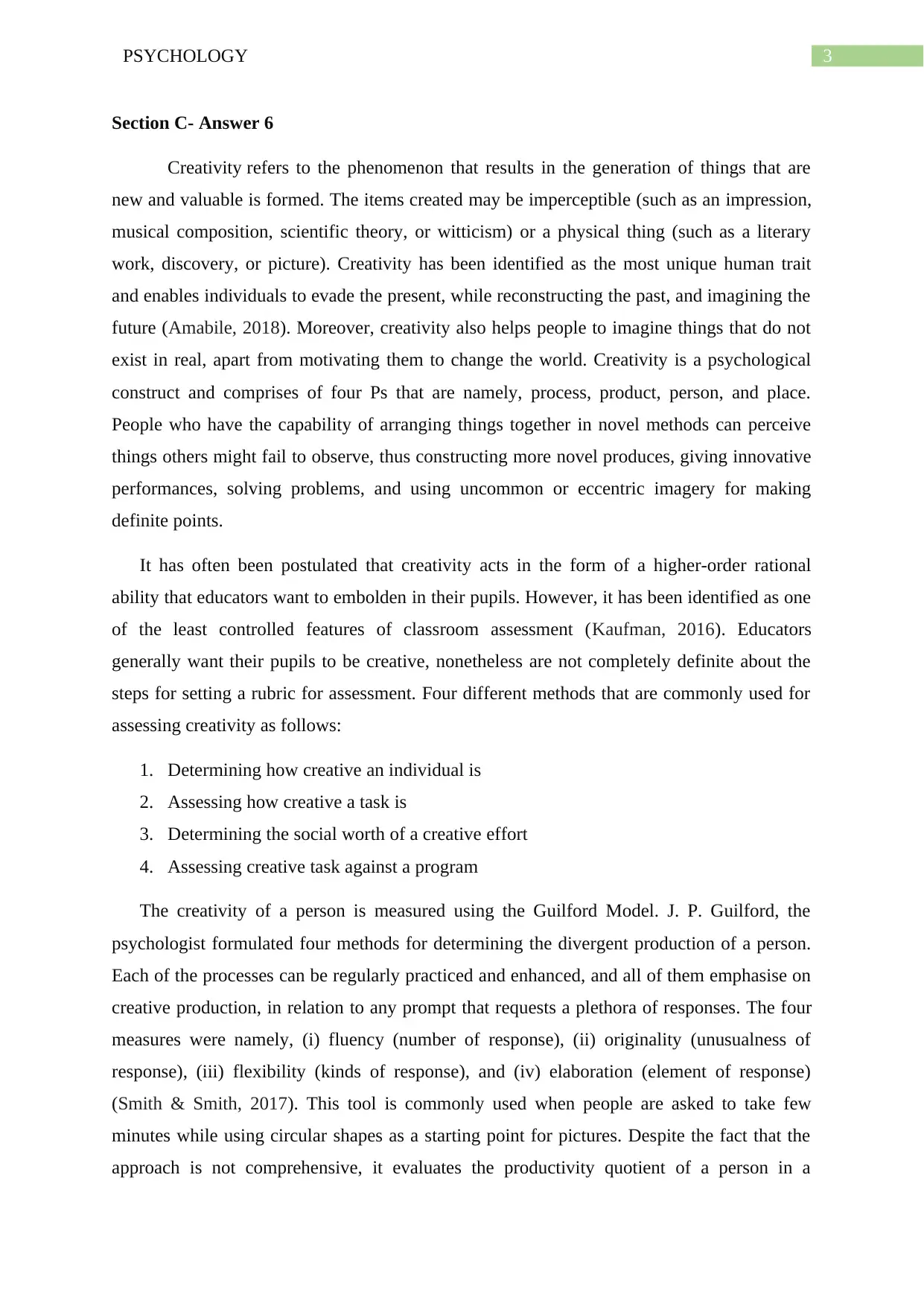
3PSYCHOLOGY
Section C- Answer 6
Creativity refers to the phenomenon that results in the generation of things that are
new and valuable is formed. The items created may be imperceptible (such as an impression,
musical composition, scientific theory, or witticism) or a physical thing (such as a literary
work, discovery, or picture). Creativity has been identified as the most unique human trait
and enables individuals to evade the present, while reconstructing the past, and imagining the
future (Amabile, 2018). Moreover, creativity also helps people to imagine things that do not
exist in real, apart from motivating them to change the world. Creativity is a psychological
construct and comprises of four Ps that are namely, process, product, person, and place.
People who have the capability of arranging things together in novel methods can perceive
things others might fail to observe, thus constructing more novel produces, giving innovative
performances, solving problems, and using uncommon or eccentric imagery for making
definite points.
It has often been postulated that creativity acts in the form of a higher-order rational
ability that educators want to embolden in their pupils. However, it has been identified as one
of the least controlled features of classroom assessment (Kaufman, 2016). Educators
generally want their pupils to be creative, nonetheless are not completely definite about the
steps for setting a rubric for assessment. Four different methods that are commonly used for
assessing creativity as follows:
1. Determining how creative an individual is
2. Assessing how creative a task is
3. Determining the social worth of a creative effort
4. Assessing creative task against a program
The creativity of a person is measured using the Guilford Model. J. P. Guilford, the
psychologist formulated four methods for determining the divergent production of a person.
Each of the processes can be regularly practiced and enhanced, and all of them emphasise on
creative production, in relation to any prompt that requests a plethora of responses. The four
measures were namely, (i) fluency (number of response), (ii) originality (unusualness of
response), (iii) flexibility (kinds of response), and (iv) elaboration (element of response)
(Smith & Smith, 2017). This tool is commonly used when people are asked to take few
minutes while using circular shapes as a starting point for pictures. Despite the fact that the
approach is not comprehensive, it evaluates the productivity quotient of a person in a
Section C- Answer 6
Creativity refers to the phenomenon that results in the generation of things that are
new and valuable is formed. The items created may be imperceptible (such as an impression,
musical composition, scientific theory, or witticism) or a physical thing (such as a literary
work, discovery, or picture). Creativity has been identified as the most unique human trait
and enables individuals to evade the present, while reconstructing the past, and imagining the
future (Amabile, 2018). Moreover, creativity also helps people to imagine things that do not
exist in real, apart from motivating them to change the world. Creativity is a psychological
construct and comprises of four Ps that are namely, process, product, person, and place.
People who have the capability of arranging things together in novel methods can perceive
things others might fail to observe, thus constructing more novel produces, giving innovative
performances, solving problems, and using uncommon or eccentric imagery for making
definite points.
It has often been postulated that creativity acts in the form of a higher-order rational
ability that educators want to embolden in their pupils. However, it has been identified as one
of the least controlled features of classroom assessment (Kaufman, 2016). Educators
generally want their pupils to be creative, nonetheless are not completely definite about the
steps for setting a rubric for assessment. Four different methods that are commonly used for
assessing creativity as follows:
1. Determining how creative an individual is
2. Assessing how creative a task is
3. Determining the social worth of a creative effort
4. Assessing creative task against a program
The creativity of a person is measured using the Guilford Model. J. P. Guilford, the
psychologist formulated four methods for determining the divergent production of a person.
Each of the processes can be regularly practiced and enhanced, and all of them emphasise on
creative production, in relation to any prompt that requests a plethora of responses. The four
measures were namely, (i) fluency (number of response), (ii) originality (unusualness of
response), (iii) flexibility (kinds of response), and (iv) elaboration (element of response)
(Smith & Smith, 2017). This tool is commonly used when people are asked to take few
minutes while using circular shapes as a starting point for pictures. Despite the fact that the
approach is not comprehensive, it evaluates the productivity quotient of a person in a
Paraphrase This Document
Need a fresh take? Get an instant paraphrase of this document with our AI Paraphraser
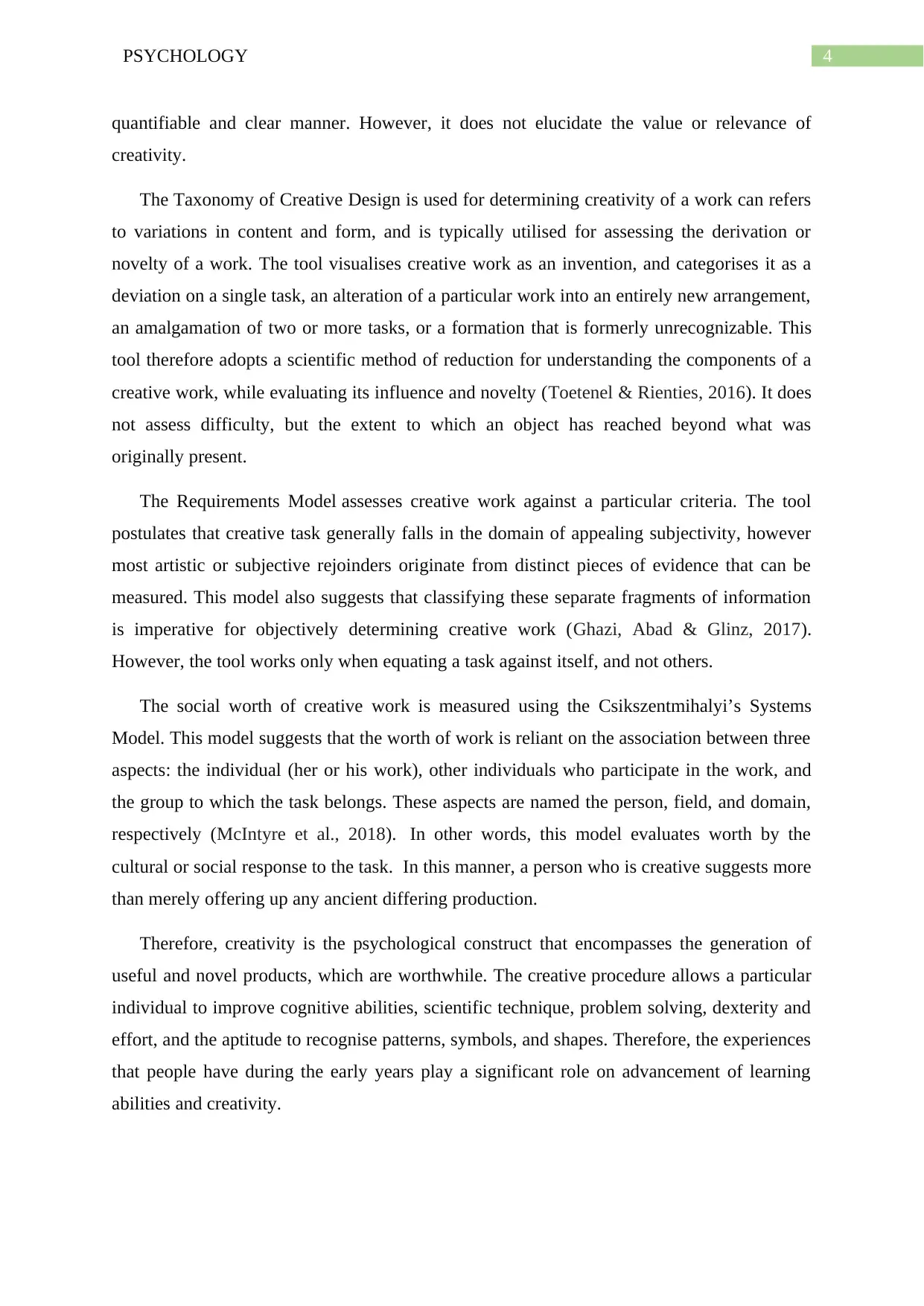
4PSYCHOLOGY
quantifiable and clear manner. However, it does not elucidate the value or relevance of
creativity.
The Taxonomy of Creative Design is used for determining creativity of a work can refers
to variations in content and form, and is typically utilised for assessing the derivation or
novelty of a work. The tool visualises creative work as an invention, and categorises it as a
deviation on a single task, an alteration of a particular work into an entirely new arrangement,
an amalgamation of two or more tasks, or a formation that is formerly unrecognizable. This
tool therefore adopts a scientific method of reduction for understanding the components of a
creative work, while evaluating its influence and novelty (Toetenel & Rienties, 2016). It does
not assess difficulty, but the extent to which an object has reached beyond what was
originally present.
The Requirements Model assesses creative work against a particular criteria. The tool
postulates that creative task generally falls in the domain of appealing subjectivity, however
most artistic or subjective rejoinders originate from distinct pieces of evidence that can be
measured. This model also suggests that classifying these separate fragments of information
is imperative for objectively determining creative work (Ghazi, Abad & Glinz, 2017).
However, the tool works only when equating a task against itself, and not others.
The social worth of creative work is measured using the Csikszentmihalyi’s Systems
Model. This model suggests that the worth of work is reliant on the association between three
aspects: the individual (her or his work), other individuals who participate in the work, and
the group to which the task belongs. These aspects are named the person, field, and domain,
respectively (McIntyre et al., 2018). In other words, this model evaluates worth by the
cultural or social response to the task. In this manner, a person who is creative suggests more
than merely offering up any ancient differing production.
Therefore, creativity is the psychological construct that encompasses the generation of
useful and novel products, which are worthwhile. The creative procedure allows a particular
individual to improve cognitive abilities, scientific technique, problem solving, dexterity and
effort, and the aptitude to recognise patterns, symbols, and shapes. Therefore, the experiences
that people have during the early years play a significant role on advancement of learning
abilities and creativity.
quantifiable and clear manner. However, it does not elucidate the value or relevance of
creativity.
The Taxonomy of Creative Design is used for determining creativity of a work can refers
to variations in content and form, and is typically utilised for assessing the derivation or
novelty of a work. The tool visualises creative work as an invention, and categorises it as a
deviation on a single task, an alteration of a particular work into an entirely new arrangement,
an amalgamation of two or more tasks, or a formation that is formerly unrecognizable. This
tool therefore adopts a scientific method of reduction for understanding the components of a
creative work, while evaluating its influence and novelty (Toetenel & Rienties, 2016). It does
not assess difficulty, but the extent to which an object has reached beyond what was
originally present.
The Requirements Model assesses creative work against a particular criteria. The tool
postulates that creative task generally falls in the domain of appealing subjectivity, however
most artistic or subjective rejoinders originate from distinct pieces of evidence that can be
measured. This model also suggests that classifying these separate fragments of information
is imperative for objectively determining creative work (Ghazi, Abad & Glinz, 2017).
However, the tool works only when equating a task against itself, and not others.
The social worth of creative work is measured using the Csikszentmihalyi’s Systems
Model. This model suggests that the worth of work is reliant on the association between three
aspects: the individual (her or his work), other individuals who participate in the work, and
the group to which the task belongs. These aspects are named the person, field, and domain,
respectively (McIntyre et al., 2018). In other words, this model evaluates worth by the
cultural or social response to the task. In this manner, a person who is creative suggests more
than merely offering up any ancient differing production.
Therefore, creativity is the psychological construct that encompasses the generation of
useful and novel products, which are worthwhile. The creative procedure allows a particular
individual to improve cognitive abilities, scientific technique, problem solving, dexterity and
effort, and the aptitude to recognise patterns, symbols, and shapes. Therefore, the experiences
that people have during the early years play a significant role on advancement of learning
abilities and creativity.

5PSYCHOLOGY
⊘ This is a preview!⊘
Do you want full access?
Subscribe today to unlock all pages.

Trusted by 1+ million students worldwide
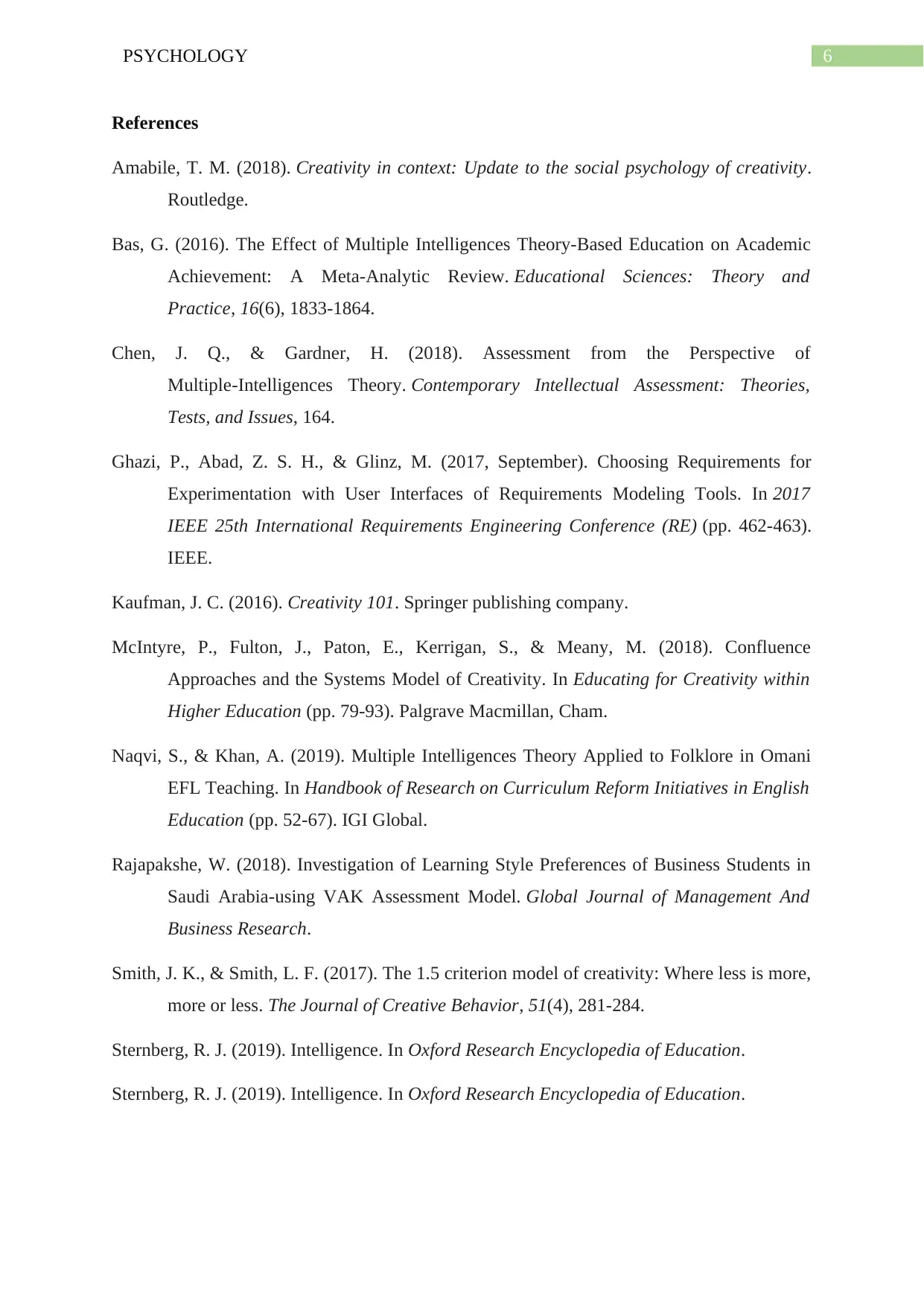
6PSYCHOLOGY
References
Amabile, T. M. (2018). Creativity in context: Update to the social psychology of creativity.
Routledge.
Bas, G. (2016). The Effect of Multiple Intelligences Theory-Based Education on Academic
Achievement: A Meta-Analytic Review. Educational Sciences: Theory and
Practice, 16(6), 1833-1864.
Chen, J. Q., & Gardner, H. (2018). Assessment from the Perspective of
Multiple-Intelligences Theory. Contemporary Intellectual Assessment: Theories,
Tests, and Issues, 164.
Ghazi, P., Abad, Z. S. H., & Glinz, M. (2017, September). Choosing Requirements for
Experimentation with User Interfaces of Requirements Modeling Tools. In 2017
IEEE 25th International Requirements Engineering Conference (RE) (pp. 462-463).
IEEE.
Kaufman, J. C. (2016). Creativity 101. Springer publishing company.
McIntyre, P., Fulton, J., Paton, E., Kerrigan, S., & Meany, M. (2018). Confluence
Approaches and the Systems Model of Creativity. In Educating for Creativity within
Higher Education (pp. 79-93). Palgrave Macmillan, Cham.
Naqvi, S., & Khan, A. (2019). Multiple Intelligences Theory Applied to Folklore in Omani
EFL Teaching. In Handbook of Research on Curriculum Reform Initiatives in English
Education (pp. 52-67). IGI Global.
Rajapakshe, W. (2018). Investigation of Learning Style Preferences of Business Students in
Saudi Arabia-using VAK Assessment Model. Global Journal of Management And
Business Research.
Smith, J. K., & Smith, L. F. (2017). The 1.5 criterion model of creativity: Where less is more,
more or less. The Journal of Creative Behavior, 51(4), 281-284.
Sternberg, R. J. (2019). Intelligence. In Oxford Research Encyclopedia of Education.
Sternberg, R. J. (2019). Intelligence. In Oxford Research Encyclopedia of Education.
References
Amabile, T. M. (2018). Creativity in context: Update to the social psychology of creativity.
Routledge.
Bas, G. (2016). The Effect of Multiple Intelligences Theory-Based Education on Academic
Achievement: A Meta-Analytic Review. Educational Sciences: Theory and
Practice, 16(6), 1833-1864.
Chen, J. Q., & Gardner, H. (2018). Assessment from the Perspective of
Multiple-Intelligences Theory. Contemporary Intellectual Assessment: Theories,
Tests, and Issues, 164.
Ghazi, P., Abad, Z. S. H., & Glinz, M. (2017, September). Choosing Requirements for
Experimentation with User Interfaces of Requirements Modeling Tools. In 2017
IEEE 25th International Requirements Engineering Conference (RE) (pp. 462-463).
IEEE.
Kaufman, J. C. (2016). Creativity 101. Springer publishing company.
McIntyre, P., Fulton, J., Paton, E., Kerrigan, S., & Meany, M. (2018). Confluence
Approaches and the Systems Model of Creativity. In Educating for Creativity within
Higher Education (pp. 79-93). Palgrave Macmillan, Cham.
Naqvi, S., & Khan, A. (2019). Multiple Intelligences Theory Applied to Folklore in Omani
EFL Teaching. In Handbook of Research on Curriculum Reform Initiatives in English
Education (pp. 52-67). IGI Global.
Rajapakshe, W. (2018). Investigation of Learning Style Preferences of Business Students in
Saudi Arabia-using VAK Assessment Model. Global Journal of Management And
Business Research.
Smith, J. K., & Smith, L. F. (2017). The 1.5 criterion model of creativity: Where less is more,
more or less. The Journal of Creative Behavior, 51(4), 281-284.
Sternberg, R. J. (2019). Intelligence. In Oxford Research Encyclopedia of Education.
Sternberg, R. J. (2019). Intelligence. In Oxford Research Encyclopedia of Education.
Paraphrase This Document
Need a fresh take? Get an instant paraphrase of this document with our AI Paraphraser
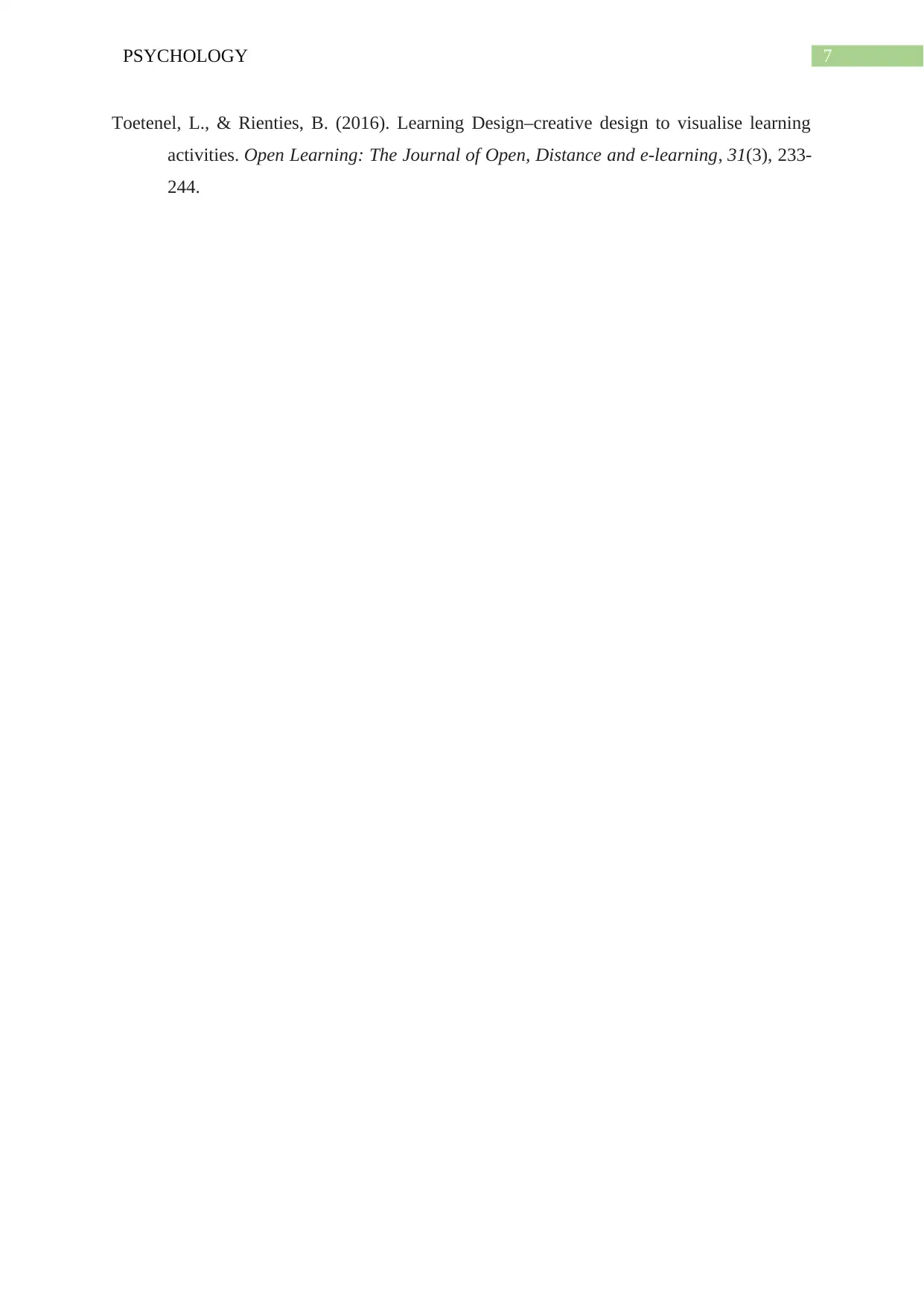
7PSYCHOLOGY
Toetenel, L., & Rienties, B. (2016). Learning Design–creative design to visualise learning
activities. Open Learning: The Journal of Open, Distance and e-learning, 31(3), 233-
244.
Toetenel, L., & Rienties, B. (2016). Learning Design–creative design to visualise learning
activities. Open Learning: The Journal of Open, Distance and e-learning, 31(3), 233-
244.
1 out of 8
Related Documents
Your All-in-One AI-Powered Toolkit for Academic Success.
+13062052269
info@desklib.com
Available 24*7 on WhatsApp / Email
![[object Object]](/_next/static/media/star-bottom.7253800d.svg)
Unlock your academic potential
Copyright © 2020–2025 A2Z Services. All Rights Reserved. Developed and managed by ZUCOL.





